What Role Does the Us Government Play With Respect to Market Competition?
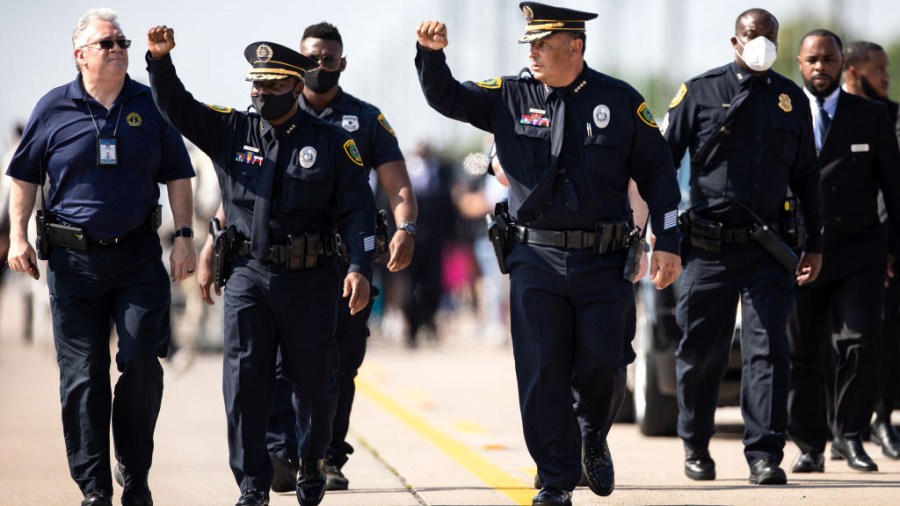
The voice of the people — at to the lowest degree the majority of the people — reigns supreme in a democratic gild, then the people in that democracy should obviously accept a say in the role of a segment as essential every bit the police. We rely on the law to maintain law and guild and keep citizens condom. In a perfect society, that is exactly what would happen, but society isn't perfect, and that isn't always the end consequence.
Many people recollect incidents involving constabulary brutality and excessive force are the natural consequence of a degenerating society plagued with unresolved social and racial inequalities and other problems. Maybe that's true to some extent, but it'southward also possible the problem could be rooted in behaviors and practices that date back to the starting time of policing in America. To understand what that ways, permit's take a look at the history of the police in the U.S.
Colonial Night Watch
Although social society has e'er been a core component of civilized society, actual constabulary forces oasis't always been the authority behind that control. Historically speaking, police officers are a relatively modernistic invention. In the earliest days of Colonial America, most towns relied on a simple system of night watchmen to preclude crime and watch out for trouble. Dark watches were established as early as 1636 in Boston and 1658 in New York, mostly for the purpose of watching for irenic crimes similar gambling and prostitution.
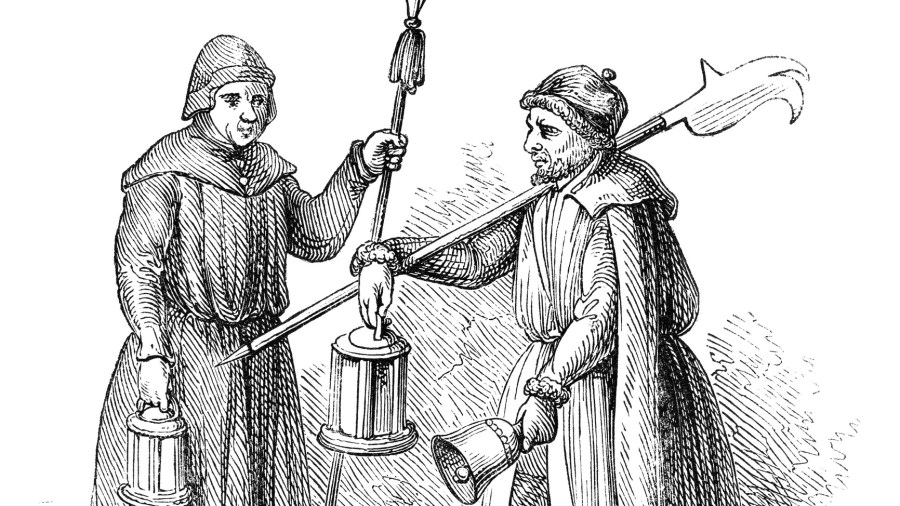
The men in the towns were obligated to participate in dark watches, but many didn't want to exercise it and didn't take the job seriously. Some were even guilty of drinking or falling comatose while on duty. Wealthy residents frequently paid others to serve on the night watch in their place, and those they paid were often (ironically) criminals themselves. In some cases, serving on the night lookout was assigned as a punishment.
Southern Slave Patrols
Early America was built on the thought of exploiting unlike kinds of labor. For people who settled in cities and towns in the North, it involved exploiting immigrants and the poor. For those in the South, it meant relying on slave labor. While dark watches dominated in the Due north, slave owners in the S drove the birth of the Southern law arrangement by creating slave patrols to enforce laws. The patrols consisted of 3 to 6 white men armed with whips and guns.
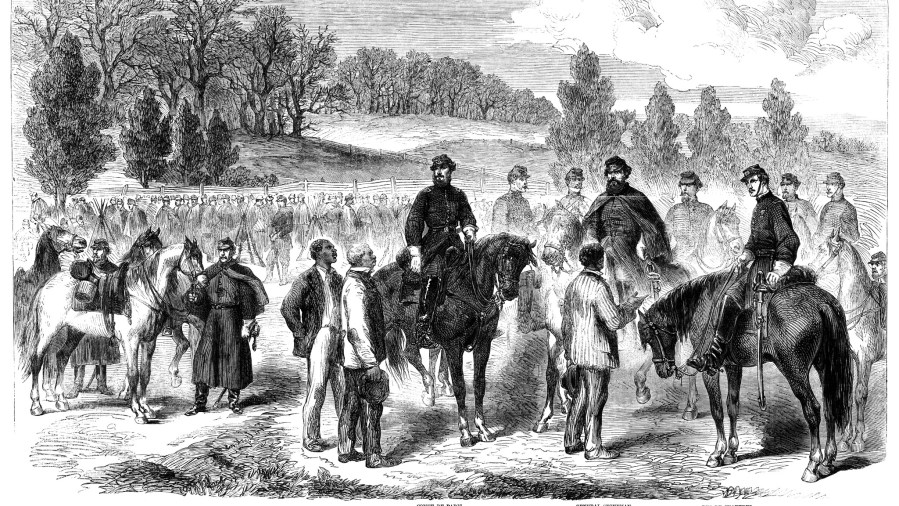
The first slave patrol was formed in the Carolina colonies in 1704 for the purpose of tracking delinquent slaves and returning them to their owners. The patrolmen too used terror tactics to intimidate slaves and forestall revolts. Following the Civil War, these groups largely transitioned into police force organizations that focused intensely on controlling freed slaves by enforcing segregation laws or vigilante groups like the Ku Klux Klan, who operated with the sole purpose of threatening, injuring and even killing Blackness people and other minorities similar Native Americans.
Virtually all white men had to serve on slave patrols, whether they owned slaves or not. Unfortunately, this do created a sense of responsibility in white people that information technology was their duty to monitor the lives and movements of Black people. Additionally, the concept of treating enslaved people similar they were property created the imitation illusion that white people had the right to inflict physical penalty.
Nascency of the Organized Police Force
As cities began to abound larger throughout u.s., dark watch systems couldn't handle the increasing sizes. In the northern states, merchants and other types of businessmen recognized the need for a solution and settled on an idea that would take the cost of security off their shoulders and make information technology a public expense. Every bit a issue, the first official organized police force began operating in Boston in 1838. Similar organizations started in New York City in 1845, Albany and Chicago in 1851, New Orleans and Cincinnati in 1853, Philadelphia in 1855, and Newark and Baltimore in 1857.
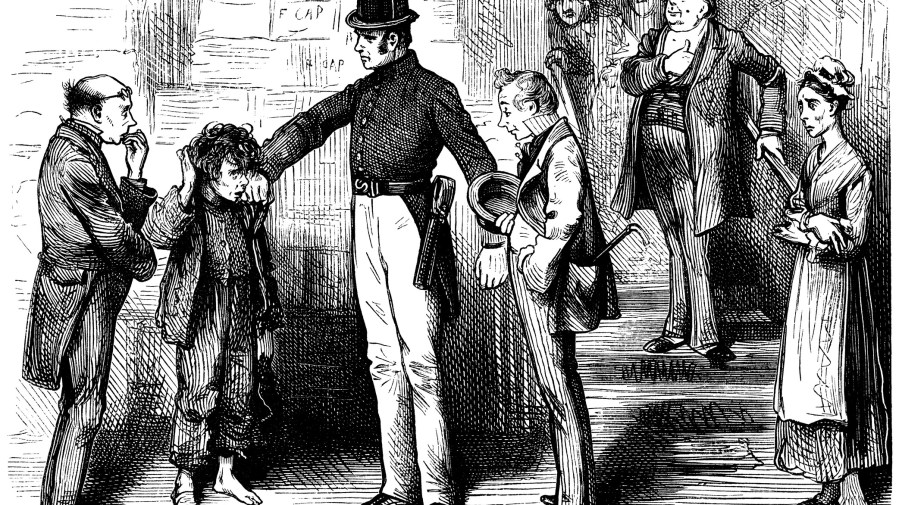
Early police forces had a few things in mutual with modern police, such as relying on public (city) funding to pay full-fourth dimension officers who weren't volunteers, but they were generally dissimilar from what we run across today. Immigrants continued to pour into the country, and many of those immigrants — Germans, Irish, Eastern Europeans, etc. — clashed with citizens who had mostly British and Dutch origins. Criminal offense rates started to rise, and newly created police forces were tasked with putting a stop to information technology — with violence, if necessary.
The most powerful, wealthiest Americans controlled the actions of the law and directed them to keep immigrants, minorities and fifty-fifty poor white people downtrodden and "in their place" by criminalizing very small transgressions and resorting to abuse. Their primary duties should accept been preventing crime and maintaining order, just they were politically and economically motivated to keep the social hierarchy intact instead. Ultimately, all the types of early policing in the U.Southward. were established based on two elements: controlling slaves and decision-making minorities.
Rise of the Political Era of Policing (Mid-1800s to Early on 1900s)
During the Ceremonious War, the military machine served every bit the principal class of law enforcement in the S, followed by sheriffs during the Reconstruction period. The sheriffs were appointed by governors, primarily to maintain police and gild in less populated areas. Most were decadent and focused more than of their attention on maintaining segregation than law and order. In the cities, police forces became increasingly common, but policing was strongly tied to politics at the time. The concept of maintaining law and order unremarkably depended on the self-interests of the most powerful individuals in the city, who determined what "guild" should look like. Local political leaders often selected police leaders, and bribes and payoffs were common.
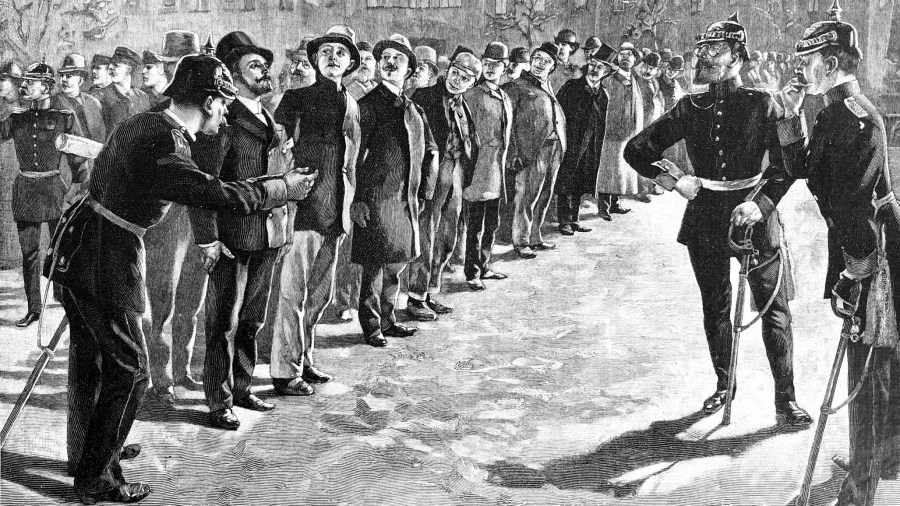
Detective units that focused on investigating crimes first started to appear in law departments in the 1850s. Allan Pinkerton's famous group of private detectives rose to fame during this period as professionals who put a end to railroad train robberies and union strikes. Urban center constabulary officers besides actively focused on preventing strikes after the Civil War to preserve the financial interests of wealthy business owners, and they had no qualms about using brutal methods to forcefulness demonstrators to finish.
In the post-Civil War era, the wealthy upper grade and merchants promoted the concept of "dangerous classes" of people. These classes consisted of anybody the elite viewed equally inferior, which was generally poor whites, immigrants and free Blacks. Instead of following logical standards of reacting to crime, police officers began to focus on preventing criminal offence from ever happening past scrutinizing the dangerous classes.
During this time, alarm boxes allowed business owners to alert police officers, and patrol wagons started being used to send big numbers of people arrested all at once, frequently those who were striking or protesting. Merchants pressured constabulary officers to article of clothing uniforms to make them easier to spot in crowds, a practice that withal exists today. Police officers began carrying firearms during this period, even earlier they were officially granted permission to arm themselves.
By the early 1900s, state police force agencies started to announced, mostly to further control workers by enforcing "public society" laws. Every bit a whole, police departments supported specific political allies and persecuted and arrested political enemies. Politicians were behind much of the original types of organized law-breaking, such as gambling, racketeering and prostitution, and at the turn of the 20th century, police forces were little more than enforcers for organized criminal offense.
Ascension of the Reform Era of Policing (Early on 1900s to 1960s)
At the shut of the 19th century, city police officers more often than not focused on policing the poor and ethnic groups accounted potentially dangerous past the aristocracy and wealthy members of club who were in accuse. During what is known as the Peachy Migration, large numbers of Blacks left the South and rural areas and moved to large cities. Equally Black urban center populations grew, the thought persisted that Blacks were a dangerous class and needed to be monitored — sometimes to the bespeak of harassment — more than white people.
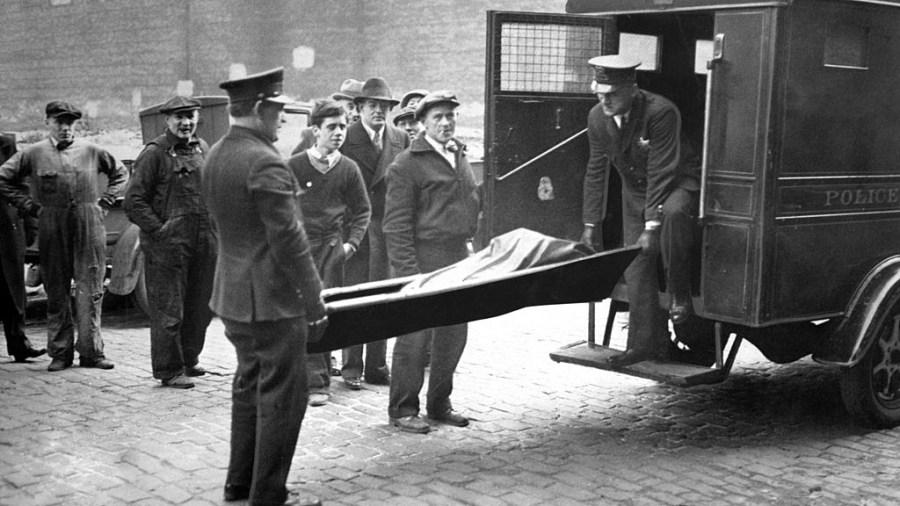
In the early 1900s, August Vollmer — ofttimes called the "father of modern policing" — recognized the issues with American policing and developed a comprehensive plan to reform the system. His approach mostly focused on incorporating social work and psychology into policing. He also created a separate judicial arrangement for juveniles and promoted the cosmos of country and federal police forces to cope with Prohibition violations and the rise of organized crime. Motivated past Vollmer, police forces began to motion toward more professional codes of behave based on much more respectable behavior.
Attempts at reform sometimes involved investigative commissions that were established to focus on specific types of criminal activities within police force departments. In New York Urban center, the Lenox Commission (1894) was one of the earliest examples and focused on constabulary extortion related to prostitution. The Curren Committee (1913) also focused on police ties to prostitution also as gambling, while the Seabury Committee (1932) turned its attention to corruption related to Prohibition (1919-1933), a period when speakeasies ofttimes popped up in major cities, and officers took bribes to ignore them.
On a national scale, President Herbert Hoover created the Wickersham Commission in 1929 to investigate illegal activities and bug with police forces all across the country. The commission also conducted the kickoff investigation into organized crime in America. Other prominent cities that established commissions to spearhead broad investigations during this period included Philadelphia, New Orleans, San Francisco, Atlanta and Los Angeles.
Attempts were as well made to reform police departments past installing new leadership and implementing a testing system for promotions inside a police section. Departments established specific choice standards and training requirements and incorporated civil service tasks into the chore description. The stop result was a system with more hierarchy and a clear chain of command. The new system separated police force from politicians and created special squads for certain types of crimes, such as narcotics, vice, investigations and traffic.
Landmark court cases during this period too forced specific reforms on police departments by dictating the mode certain processes had to be legally handled. Due process was beginning addressed in Mapp v. Ohio in 1961, when a gauge laid downwards strict rules to prevent illegal searches and seizures in criminal cases. In Escobedo five. Illinois in 1964, the approximate determined a suspect is entitled to an attorney, and any statements made without an attorney aren't admissible in court. Peradventure the nearly well-known case, Miranda v. Arizona in 1966, dictates that a suspect must exist informed of all rights before they can exist questioned.
Police Professionalism Move (1950s to 1970s)
At the stop of the Reform Era, a movement known as police force professionalism took hold in many police departments beyond the country. O.West. Wilson first established the concepts of police professionalism in the 1950s. The move promotes military-way arrangement with a centralized command unit of measurement and pushed for the added accomplish of motorized patrols instead of foot patrols.
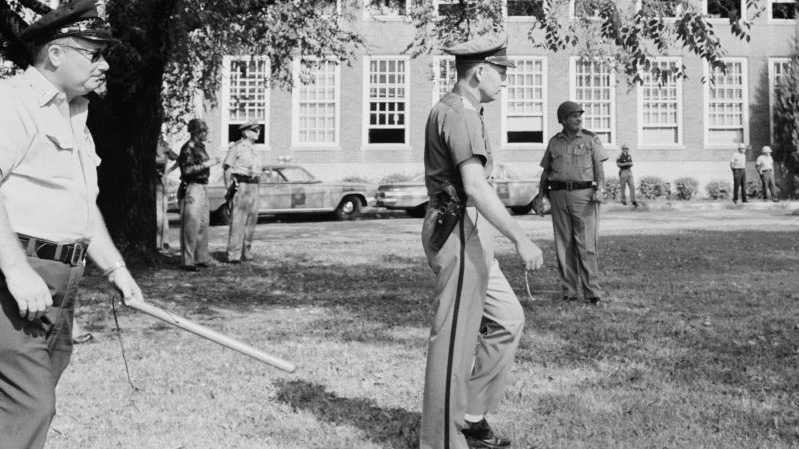
Unfortunately, many of the newly adopted procedures led to resentment of the law in many communities, partially due to racial profiling that targeted minorities as potential criminals without crusade. Officers isolated themselves from the public and were resistant to complaints and criticism. By the mid-1960s, police unions were created to protect officers. Most police force departments in big cities had a police union by the early 1970s. In add-on to protecting officers, unions implemented compulsion tactics like "blueish flu" and work slowdowns to demand things like pay raises and equipment upgrades.
The "Taylorization" of the law — terminology borrowed from the manufacturing plant manufacture related to optimization — involved downsizing law forces and focusing on job specialization. Patrols went from two officers in a machine to one, and new technology, such as the 911 system, was implemented to help officers do their jobs. Some of the more mundane jobs were passed off to civilians to consummate. Unfortunately, some of the measures meant to improve their capabilities actually widened the divide between police officers and the public.
The relationship became even more strained when constabulary departments used forcefulness to command protesters during the Civil Rights Movement and Vietnam War protests. Many situations got out of manus, and instead of protecting the peace, law officers became a common source of social tension. Throughout the 1960s, Blacks and minorities began to protest police treatment itself, engaging in everything from peaceful protests, boycotts and sit-ins to out-of-command riots, and the police response was often harsh and violent.
In 1969, the Stonewall riots lasted six days when the LGBTQ community fought back after a police raid of Stonewall Inn in New York City. This event ultimately led to the Gay Rights Movement. Past the mid-1970s, the country was largely dissatisfied with policing and distrustful of police officers. To make matters worse, research studies in the late 1960s and early 1970s showed that police patrols didn't prevent crime, and assigning detectives to work cases didn't meliorate rates for solving crimes.
Diversity among police officers remained rare during this period as well, with women only accounting for approximately 2% of officers in 1970 and racial or ethnic minorities accounting for less than 10%. Those numbers did eventually meliorate to 13% women and 25% minorities in 2017.
Rising of the Customs Problem-Solving Era of Policing (1970s to Nowadays)
In the 1970s, police administrators began to recognize that law officers deal with many behaviors that aren't criminal, such equally psychological behaviors and social problems. As a issue, they began to focus on ways to accost those issues and turn police force officers into allies instead of adversaries. Gradually, they initiated community policing strategies that called on communities to work in conjunction with the police to control offense and solve other community bug, including those related to social problems and mental health.
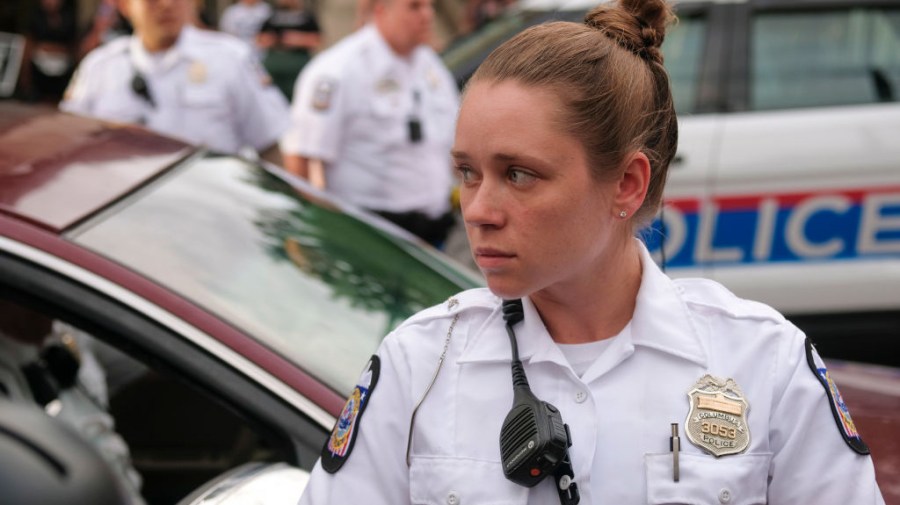
The goal of customs policing is to decentralize the police force and so officers can establish positive relationships with their communities. If trying to control crime through a police presence and intimidation was unsuccessful, then they believed collaboration and trust could be the answer. The idea is that information technology'south far too difficult to command crime and maintain club without a strong connectedness to the community.
Community policing uses resource to solve problems rather than just respond to issues equally they happen. By the early 21st century, two-thirds of local police departments relied on community policing strategies around the state for dealing with common local crimes and civic duties. Additionally, new specialty divisions were created equally new threats appeared. The 1999 Columbine school shooting triggered the development of new, more than effective processes for treatment mass shootings, for example.
In 2001, the 9/11 terrorist attacks led to the establishment of highly skilled counterterrorism units. Unfortunately, the heightened level of diligence combined with the trauma also led to increased racial profiling in some communities. After 9/11, the number of accusations regarding police force brutality, excessive force and racial profiling started to increase once over again. Some highly publicized deaths led some departments to start using trunk cameras, just torso cameras don't always seem to influence behavior when tensions run high.
Finding a Manner Forward
Casting officers in roles that make them part of the community is a positive motility that has taken police departments as a whole in the right management, but bug still occur at times that issue in face-offs between the police and the public. Lingering racist ways of thinking near criminal offence that date back to the early days of policing in America could be partially to blame. If training for officers still includes elements of race, religion or social form when learning how to spot suspicious deportment or a potentially dangerous person, then the preparation protocols certainly need to change immediately.
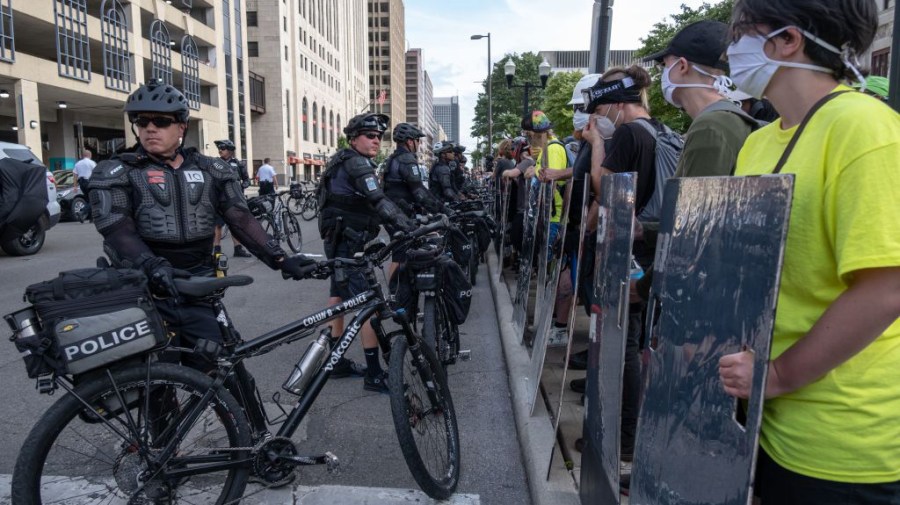
Additionally, mod police budgets swallow up all the funds that could get to services needed to help society, which could in turn reduce the number of people committing crimes and going to jail. More money spent on social programs versus policing could reduce harm to citizens every bit a whole. This is what almost people have in mind when they call for a motion to defund the law. Nearly people don't desire to eliminate the law force; they desire to refocus some of the coin to fund social and mental health programs to better handle individuals who create disorder simply aren't criminals.
Protests all over America demand modify at the to the lowest degree or even the elimination of the police at the almost extreme. Speaking out against acts of police force brutality is our correct and our social responsibility, but the situation becomes more complicated when those protests lead to riots, vandalism, arson and other crimes that crave law intervention for the protection of bystanders, business organisation owners and belongings. When you await at the history of the law in the U.Due south., it's clear that the police have come up a long manner and improved dramatically in the by iv centuries, only that doesn't mean they have fully evolved to what nosotros demand them to exist. We can simply hope the contempo protests ultimately atomic number 82 to the continued development that will go along moving policing in a positive direction.
Source: https://www.reference.com/world-view/police-important-democratic-society-f076b4e00ea6871b?utm_content=params%3Ao%3D740005%26ad%3DdirN%26qo%3DserpIndex
0 Response to "What Role Does the Us Government Play With Respect to Market Competition?"
Post a Comment